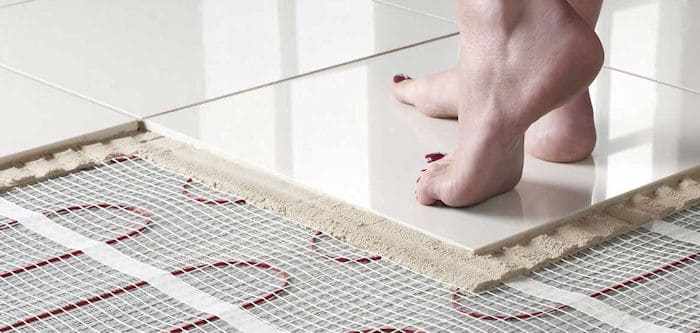With an almost unlimited choice of patterns, textures and colours to please even the most fastidious tastes. Bathroom tiles are the obvious choice for lining your bathroom or shower area.
Although some people consider leaving it to the professionals. Most bathrooms can be tiled in a weekend or two. Even if you have had no previous tiling experience.

Before you begin, here are the essential tools you’ll need for the job:-
- Tile Cutter
- Tile Saw
- Grout Spreader
- Spirit Level
- Tile Nibblers
- Adhesive Spreader
- Tile-Cutting Jig
- Battens
PREPARATION
Before you begin, it is imperative that the walls are clean, sound and dry. The surface should be as flat as possible. Therefore you will need to remove any wallpapering and coat any flaking paint with a stabilizing primer.
SETTING OUT THE TILES
For a really professional finish. This is perhaps the most important part of the whole tiling job. The size and shape of your bathroom ultimately decides on how you set out the walls. Firstly, you should measure the height of the room and divide it by two. This will ensure that the ‘cuts’ at the top and the bottom will be the same length. Again, you should then measure the width and likewise determine the centre of the wall. This is because, when you look at the wall in its entirety. It will always look better if all the ‘cuts’ are the same size at both sides and top and bottom. It looks more professional and makes it easier to lose any discrepancies if your wall corners are out of plumb. So, working from your centre point, measure up and down the wall, marking off where the tiles will sit.
Once we have done that…
From each mark you have made on the wall. Quickly run a spirit level across the face of the wall to guage how the tiles will look against windows etc. This will show us what size cuts will be required at that particular point. We are aiming for cuts of no less than 1” or 25mm. If your cuts are smaller than that. Adjust your centre line up or down to accommodate the best arrangement to suit the room. From there, simply mark down the wall to where the first full tile will start. Mark the bottom of the lowest full row of tiles. And temporarily nail a thin guide batten to the wall, aligned with the mark. Use the spirit level to ensure that this is perfectly horizontal.
Now, marking the centre of the width of the wall, repeat the last step vertically. If the border tiles measure less than half the width of a tile. Re-position the rows sideways by half a tile. Eventually, this will determine the best ‘centre’ position to begin from. Please bear in mind that although this piece is aimed at tiling just one wall. The rest of the room should also be taken into consideration for all horizontal and vertical cuts you will encounter. Granted, this is the most head achy part of the whole job. But at this stage it has cost us nothing and getting it all right now will save time, materials and effort in the long term. And it will make the difference between a bodged effort and a professional looking job.

APPLYING THE ADHESIVE
It’s important to always use a waterproof tile adhesive for areas that will come into contact with water. Most tile adhesives are sold ready-mixed, although some will require you to add water yourself. For small tiles, it is easier to apply the adhesive by spreading the walls. Apply the adhesive to the wall so that it covers about 1 metre square. Using the toothed edge of the spreader, form horizontal ridges in the adhesive. Take the first tile and position it where you have determined your working centre is. If the tiles do not have lugs, place plastic spacers between them. To ensure that there is enough space for the grouting. With larger tiles it is more conventional to dab the tiles individually with adhesive. And to press the tiles against the wall firmly.

It is worth noting here that in my opinion. Although working with the adhesive, we are not actually gluing the tiles.
What we are doing, is laying the tiles flat. Ensuring that as we go, the finished wall will be flat in appearance. What we don’t want is for the tiles to be jagged with corners standing proud all over the show. Be sure to use only the right pressure to achieve a flat surface. The real adhesion, will come in when we grout the tiles. This will lock the tiles in position and create the desired solidity of the fully tiled wall.
All tiled surfaces are made up with two elements. These are, field tiles (full tiles, generally in the middle) and border tiles or cuts (generally round all the edges). Here, we are concentrating on the field tiles. Systematically filling the whole wall area, using a damp sponge as we go. We should wipe away any adhesive from the surface of the tiles. Tile along the batten until the first rows are complete. Ensuring that each tile is perfectly horizontal. While adding subsequent rows until we reach the top.
CUTTING THE BORDER TILES
Once you have completed the main area, the border tiles will need to be cut to fit the gap between the adjacent walls. Placing the border tile face down and with one edge next to the wall, mark where it is to be cut taking into consideration normal spacing between the tiles. Use a felt tip pen or china graph pencil to transfer the mark to the face of the tile. Although more time consuming, it will make for a better job if each tile is measured and cut individually. Start at one side, go across the top and down the other side. This should leave you with a fully tiled wall excluding the final bottom row of cuts.

FITTING AROUND APPLIANCES
When fitting tiles around a pipe, it’s best to try and set them out so that you can cut a semi circle from the edges of two adjacent tiles. If this is not possible, mark the centre of the pipe on the top and side edges of the tile and draw lines across from these points. This will determine the centre of your pipe and where the tile should be drilled with an appropriately sized drill bit. If this is not possible, using a coin, or something slightly larger than the diameter of the pipe, draw around where the two lines cross.
Make a cut straight through the centre of the circle and then use a tile saw to cut out the remaining circle. To fit a tile against a curved shape, it’s best to use a piece of thin card and draw a template of the exact size of the tile. Cut small, evenly spaced slits along one edge of the tile template and press it against the curve to replicate the shape. Transfer the gradient of the curve on the template onto the face of the tile and then cut using a tile saw.
GROUTING AND SEALING
It is essential to use waterproof grout for any bath or shower surrounds. Grout usually comes in a powder to be mixed with water it is also possible these days to source coloured grouts that will blend in with your choice of tiles. For best results, allow the tile adhesive to harden for 24 hours before applying the grout using a rubber-bladed spreader, ensuring that all the joints are filled. Using a sponge, wipe the grout from the surface of the tiles before it sets and smooth the joints with a blunt-ended stick. When it has dried, use a dry cloth to polish the face of the tiles and leave for about a week before using.
Once you have fully grouted your wall, within a couple of hours it will be safe to remove your bottom supporting batten and tile the remainder of the wall with your bottom cuts. Once tiled, grout the tiles as above and the whole wall is now completed.

SEALING BATHROOM FITTINGS
You should not use grout to seal the gap between the shower tray or bathtub and the wall, since it can crack and lose its waterproof seal. It’s best to use a silicon sealant compound, which you can buy in cartridges. The sealants are again available in a choice of colours to match your choice of tile. Trim the end off the nozzle and press the tip into the joint at an angle of 45 degrees. When applying the sealant to bathtubs, it’s best to fill the bath with water since the join will usually stretch under your body weight. When you have finished, smooth over any ripples with a wetted finger tip. It is also a good idea to apply the sealant to all the internal corners of the room.
© Andy Robinson, Localad Services Handyman Assist
If you have enjoyed reading this article… Be sure to check out my many other Posts. Or better still, for up to the minute notifications of what I am up to, why not subscribe here for free?







Recent Comments